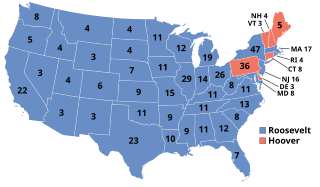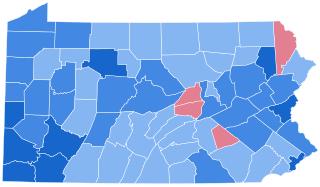
Presidential elections were held in the United States on November 4, 1856. Democratic nominee James Buchanan defeated Republican nominee John C. Frémont and Know Nothing/Whig nominee Millard Fillmore. The main issue was the expansion of slavery as facilitated by the Kansas–Nebraska Act of 1854. Buchanan defeated President Franklin Pierce at the 1856 Democratic National Convention for the nomination. Pierce had become widely unpopular in the North because of his support for the pro-slavery faction in the ongoing civil war in territorial Kansas, and Buchanan, a former Secretary of State, had avoided the divisive debates over the Kansas–Nebraska Act by being in Europe as the Ambassador to the United Kingdom.

Presidential elections were held in the United States on November 8, 1864, near the end of the American Civil War. Incumbent President Abraham Lincoln of the National Union Party easily defeated the Democratic nominee, former General George B. McClellan, by a wide margin of 212–21 in the electoral college, with 55% of the popular vote. For the election, the Republican Party and some Democrats created the National Union Party, especially to attract War Democrats.

Presidential elections were held in the United States on November 4, 1884. Democratic Governor Grover Cleveland of New York narrowly defeated Republican James G. Blaine of Maine. It was set apart by mudslinging and personal allegations that eclipsed substantive issues, such as civil administration change. Cleveland was the first Democrat elected president of the United States since James Buchanan in 1856, the first to hold office since Andrew Johnson left the White House in 1869, and the last to hold office until Woodrow Wilson, who began his first term in 1913. For this reason, 1884 is a significant election in U.S. political history, marking an interruption in the era when Republicans largely controlled the presidency between Reconstruction and the Great Depression.

Presidential elections were held in the United States on November 8, 1892. In the fourth rematch in American history, the Democratic nominee, former president Grover Cleveland, defeated the incumbent Republican President Benjamin Harrison. Cleveland's victory made him the first president in American history to be elected to a non-consecutive second term, a feat not repeated until Donald Trump was elected in 2024. The 1892 election saw the incumbent White House party defeated in three consecutive elections, which did not occur again until 2024.

Presidential elections were held in the United States on November 8, 1932. Against the backdrop of the Great Depression, incumbent Republican President Herbert Hoover was defeated in a landslide by Democrat Franklin D. Roosevelt, the governor of New York and the vice presidential nominee of the 1920 presidential election. The election marked the effective end of the Fourth Party System, which had been dominated by Republicans, and it was the first time since 1916 that a Democrat was elected president.

Marion Butler was an American politician, farmer, and lawyer. He represented North Carolina in the United States Senate for one term, serving between 1895 and 1901. At the time, he was a leader of the North Carolina Populist Party, and also affiliated with the Democratic Party and the Republican Party at different points in his career. He was the older brother of George Edwin Butler.
This article contains lists of official third party or independent candidates associated with the 2008 United States presidential election.

The 1900 New York state election was held on November 6, 1900, to elect the governor, the lieutenant governor, the Secretary of State, the state comptroller, the attorney general, the state treasurer and the state engineer, as well as all members of the New York State Assembly and the New York State Senate.

The North Carolina United States Senate election of 1978 was held on November 7, 1978 as part of the nationwide elections to the Senate. The general election was between the Republican incumbent Jesse Helms and the Democratic nominee John Ingram. Helms won re-election, by a slightly wider margin than in 1972. This was the first Senate election where Republicans were re-elected.

The 2004 House elections in Georgia occurred on November 2, 2004, to elect the members of the state of Georgia's delegation to the United States House of Representatives. Georgia has thirteen seats in the House, apportioned according to the 2000 United States census.

The Pennsylvania lieutenant gubernatorial election of 2010 was held on November 2, 2010. The winning candidates for Governor and Lieutenant Governor will serve a four-year term from 2011 to 2015. In Pennsylvania, the Lieutenant Governor is elected on the same ticket as the Governor, so the only campaign for this office was the primary election. As a result of Tom Corbett's election to the position of governor, Jim Cawley became the new Lieutenant Governor.

The 1892–93 United States Senate elections were held on various dates in various states, coinciding with former Democratic President Grover Cleveland's return to power. As these U.S. Senate elections were prior to the ratification of the Seventeenth Amendment in 1913, senators were chosen by state legislatures. Senators were elected over a wide range of time throughout 1892 and 1893, and a seat may have been filled months late or remained vacant due to legislative deadlock. In these elections, terms were up for the senators in Class 1.

The 1964 United States presidential election in Pennsylvania took place on November 3, 1964, and was part of the 1964 United States presidential election. Voters chose 29 representatives to the Electoral College, who voted for president and vice president. Pennsylvania overwhelmingly voted for the Democratic nominee, President Lyndon B. Johnson, over the Republican nominee, Senator Barry Goldwater. Johnson won Pennsylvania by a margin of 30.22%. Apart from William Howard Taft in 1912, Goldwater's 34.7% of the vote is easily the worst showing for a Republican in the state since the party was founded. Even relative to Johnson's popular vote landslide, Pennsylvania came out as 7.64% more Democratic than the nation at-large; the only occasion under the current two-party system that the state has been more anomalously Democratic than this was in Ronald Reagan's 1984 landslide.

The 2014 Connecticut gubernatorial election took place on November 4, 2014, to elect the governor and lieutenant governor of Connecticut, concurrently with elections to the United States Senate in other states and elections to the United States House of Representatives and various state and local elections.

The 1934 Pennsylvania gubernatorial election occurred on November 6, 1934. Incumbent Republican governor Gifford Pinchot was not a candidate for re-election.

The 1960 United States presidential election in Texas was held on November 8, 1960, as part of the 1960 United States presidential election. The Democratic Party candidate John F. Kennedy, narrowly won the state of Texas with 50.52 percent of the vote to the Republican candidate Vice President Richard Nixon's 48.52%, a margin of two percent, giving him the state's 24 electoral votes. Despite the presence of U.S. Senator Lyndon B. Johnson on the Democratic ticket, the result made Texas the tenth closest state in the election. Nixon's strong performance in the Dallas–Fort Worth Metroplex, Harris County, the Panhandle, and the Hill Country kept the race close.

The 1924 Nebraska gubernatorial election was held on November 4, 1924, and featured former state Senator Adam McMullen, a Republican, defeating Democratic nominee, former state Representative John N. Norton, and Progressive nominee, Omaha City Commissioner Dan B. Butler.

The 1940 Washington gubernatorial election was held on November 5, 1940. Republican nominee Arthur B. Langlie narrowly defeated Democratic nominee Clarence Dill with 50.24% of the vote. Langlie's 0.74% margin of victory is the third-closest in state history. This is the only gubernatorial election in Washington in which King County has voted for the losing candidate.

The 1932 Washington gubernatorial election was held on November 8, 1932. Democratic nominee Clarence D. Martin defeated Republican nominee John Arthur Gellatly with 57.29% of the vote.

Elections were held in Illinois on Tuesday, November 3, 1936.






















